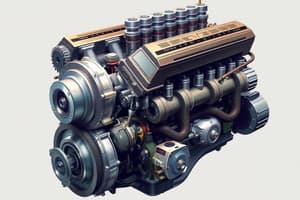Podcast
Questions and Answers
Match the following methods with their usage in cleaning engine parts:
Match the following methods with their usage in cleaning engine parts:
Wet magna flux = Detecting cracks on con rods and crankshafts Dye penetrant inspection = Testing aluminum cylinder heads/blocks
Match the following steps in vehicle repair with their sequence:
Match the following steps in vehicle repair with their sequence:
Cleaning and Washing Section = Preparing parts for inspection Dismantling Section = Removing parts for repair
Match the following tools with their purpose in repairing cracks on engine parts:
Match the following tools with their purpose in repairing cracks on engine parts:
Threaded tapper pins = Stopping cracks by drilling Ceramic seal circulators = Sealing cracks after repair
Match the following sections in vehicle repair with their tasks:
Match the following sections in vehicle repair with their tasks:
Match the following with their correct procedures:
Match the following with their correct procedures:
Match the following with their correct procedures:
Match the following with their correct procedures:
Match the following with their correct procedures:
Match the following with their correct procedures:
Match the following with their correct procedures:
Match the following with their correct procedures:
Match the following tasks with their descriptions:
Match the following tasks with their descriptions:
Match the following tools with their purposes:
Match the following tools with their purposes:
Match the following cleaning methods with their benefits:
Match the following cleaning methods with their benefits:
Match the following storage practices with their advantages:
Match the following storage practices with their advantages:
Flashcards are hidden until you start studying
Study Notes
Matching Methods and Tools in Vehicle Repair
- Match methods with their usage in cleaning engine parts
- Sequence steps in vehicle repair
- Match tools with their purpose in repairing cracks on engine parts
- Match sections in vehicle repair with their tasks
- Match procedures with their correct steps
- Match tasks with their descriptions
- Match tools with their purposes
- Match cleaning methods with their benefits
- Match storage practices with their advantages
Studying That Suits You
Use AI to generate personalized quizzes and flashcards to suit your learning preferences.




